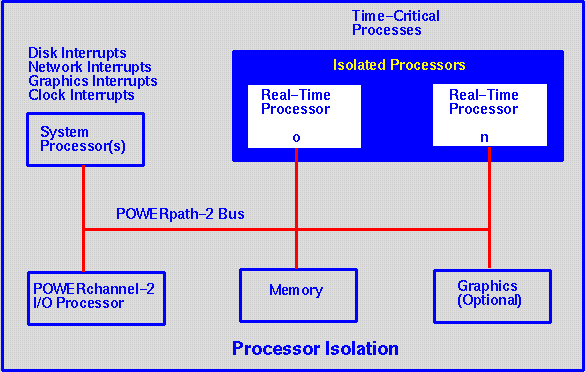

 http://www.sgi.com/products/React.html (Silicon Surf Promotional CD, 01/1995)
http://www.sgi.com/products/React.html (Silicon Surf Promotional CD, 01/1995)
REACT
REACT (tm) in IRIX (tm) Version 5
Real-Time Extensions In IRIX (tm) Version 5 For
CHALLENGE (tm) And Onyx (tm)
IRIX with REACT (tm)
delivers the advantages of a standard computing environment
to applications requiring a computer system with fast,
deterministic response to external events.
IRIX is Silicon Graphics' implementation of UNIX (r) System V, Release 4 (SVR4).
The REACT extensions to SVR4 enable users to configure their system
to deliver deterministic responses to external events.
The REACT extensions are an integral part of IRIX, and are
included in every copy.
When running on a multiprocessor
CHALLENGE server or Onyx graphics system, IRIX with REACT provides a
powerful solution for real-time simulation, data acquisition and telemetry
applications. Simulation applications include flight and vehicle simulators,
power plant simulators, and hardwarein-the-loop test simulators.
Features
Fast, Deterministic System Response
On a properly configured multiprocessor system, total interrupt
response time is less than 200 us, from occurrence of the interrupt
to initiation of the user's application process.
Full Control Over Real-Time Processors
By allocating one processor of a multiprocessor system to handle
UNIX system functions, the remaining processors can be exempt from
all system overhead, including scheduler activity. Real-time processes have
full control over these processors. The user can precisely specify assignment
of processes to processors, process priority, and routing of interrupts to
processors.
Standard UNIX
IRIX conforms to numerous application
programming interface standards, including POSIX 1003.1a,
FIPS 151-1, SVID3 and XPG3. In addition, it includes important functionality
specified in POSIX 1003.4, and in upcoming releases will become fully
compliant with this standard.
Periodic Scheduling
Internal timers can be
used to initiate frames in simulation applications. Scheduling of processes
on any subset of processors can be synchronized to a frame. Multiple
independent frame rates can be maintained concurrently.
Sub-Microsecond Accuracy Timers
On CHALLENGE and Onyx systems, each processor
includes an interval timer with submicrosecond accuracy. Each timer can
be set to interrupt its processor at intervals ranging from 400 ((***))) to
200 hours. Interrupts can be either one shot or repetitive. Each processor
also has access to a free-running timer that can be used to measure elapsed
time with sub-microsecond accuracy.
Queued Signals
Queued signals, as
outlined in POSIX 1003.4, guarantee that the number of signals received by
a process is identical to the number sent to that process. IRIX supports
64 queued signal levels, including 32 reserved for real time. The 32 realtime
signals each have a separate prio rity level. Queued real-time
signals are delivered in order of their priority.
High-Level Language Support
Support for Fortran, Ada, C and C++ enable efficient
development of highquality, real-time application software.

CHALLENGE And Onyx Hardware Features
Scalable, Shared Memory,
Symmetric Multiprocessing
A cache-coherent, shared-memory architecture
simplifies programming and communication among processors.
Scalable processor, memory, and l/O configurations can
be matched to an application, then later expanded in the field,
if needed.
High-Performance VME Buses
Base configurations include a
VME64 I/O bus capable of sustaining transfer rates of over 50 MB/Sec.
VME capability can be expanded up to 5 VME64 buses,
with 25 slots in CHALLENGE and 23 slots in Onyx. All slots are fully
compatible with 32-bit VME boards.
VME DMA Controller
Each VME bus controller includes a general-purpose, block-mode DMA controller.
This enables applications to move data using high-speed DMA transfers
between system memory and VME boards, which support only slave-mode operations.
The DMA control registers are mapped into the user's address space, eliminating
the overhead of a system call when initiating a DMA transfer.
Standard Computing Platform
Real-time applications can use the same Silicon Graphics models that are
currently in use in thousands of technical computing installations.
The performance, cost effectiveness and rapid pace of technological
improvement of these products are unmatched by proprietary real-time computer
systems.
Fast, Deterministic UNIX
IRIX with REACT includes the following
extensions to UNIX, which result in a fully deterministic
multiprocessor system that is suitable for de manding realtime applications.
Precise Priority Control
Users can assign a process to one of three priority bands: above,
equal to, or below normal UNIX processes. Within each band, processes
can be as signed to one of at least nine priority levels.
Non-Degrading Priority
Users can prevent the UNIX scheduler's aging mechanism from
decreasing the priority of a process as its run time accumulates.
This freezes the proc ess priority at the assigned level.
Memory Page Locking
Users can lock a process into memory, ensuring that it will never
incur a page fault.
Process-To-Processor Locking
On a multiprocessor system, processes can be locked onto or off of a
processor, and interrupts can be directed to specific processors.
Processor Isolation
On a multiprocessor system, processors can be isolated from interprocessor
interrupts associated with cache and memory management. Isolated processors
can communicate with any other processors via shared memory.
Disabling The UNIX Scheduler
If total user control over a subset of processors is desired,
the user can exempt those processors from being controlled by the
UNIX scheduler. This ensures that the current user process will never be
preempted (except to handle interrupts), and eliminates the overhead of
cycles spent running the scheduler. Scheduler services remain available
to run the next-highest priority process if the currently running process
yields.
Commitment To The Real-Time Market
Silicon Graphics was the first
manufacturer of general pu rpose UNIX workstations and servers
to offer a solution to demanding real-time applications.
Silicon Graphics is committed to expanding its leadership role
in offering standards-based sol utions for applications such as
real-time simulation, data acquisition and telemetry. Key elements
of this commitment include continuing enhancements of IRlX's real-
time features and tools, conformance to standards such as POSIX 1003.4,
and strong partnerships with third-party VME suppliers.





 http://www.sgi.com/products/React.html (Silicon Surf Promotional CD, 01/1995)
http://www.sgi.com/products/React.html (Silicon Surf Promotional CD, 01/1995)